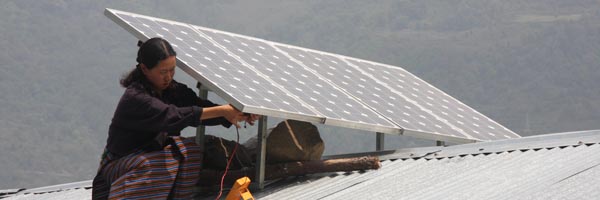Energy, gender and climate change
Energy consumption is a key contributor to climate change and features prominently in climate debates. The energy sector accounts for 60% of total greenhouse gas emissions worldwide. Though there is a need for a significant reduction, energy consumption is actually increasing worldwide, mostly due to the rapidly growing economies in countries like China, Brazil and India. At the same time, more than 2 billion people in developing countries lack access to modern energy infrastructure, especially in rural areas. In order to allow these countries to develop their economies and standard of living, and to meet their energy needs, industrialised countries – who are predominantly responsible for historical greenhouse gas emissions – must significantly reduce their energy consumption. At the same time, developing countries must strive to ensure that they follow a path of low-carbon development to the extent possible. More efficient technologies and an increased use of renewable energy can certainly contribute to a reduction in greenhouse gas emissions. Nevertheless, without a fundamental change in consumption patterns and lifestyle in industrialised countries, the required reductions will hardly be achieved.
Gender dimensions
Due to the work of the gender & energy network ENERGIA there is a huge amount of data and case studies documenting gender and energy issues in the global South. These studies clearly show gender differences in energy production, energy use, access to energy and the participation of women in energy-related planning and decision-making.
Gender-differentiated responsibilities result in different energy needs and attitudes towards energy production. Studies agree upon strong gender differences in the attitudes towards nuclear energy use worldwide. The strong rejection of nuclear energy by women is based on their higher risk perception. Gender differences are less obvious with respect to renewable energy production.
Especially in rural areas of developing countries, a lack of energy services is evident. Lack of access to energy mainly affects women in their role as household managers because they are usually responsible for providing energy for the household. Without access to convenient, affordable fuels for cooking and heating, women have to spend large amounts of time and physical energy obtaining traditional fuels (such as wood, charcoal, dung and agricultural waste) to heat water and cook meals. Furthermore, energy is often a precondition for income-generating activities.
Energy poverty is also a growing problem in industrialized countries. The rise of oil and gas prices causes increasing energy costs, affecting poor households in particular. The share of female-headed (single mothers or elderly) poor households is notably high.
Regarding energy consumption in the North, studies from various European countries show that women consume less energy than men. This is true across the different income groups as well as across different generations. Gendered transport patterns contribute particularly to this difference in energy consumption, but it is also reflected in other sectors like household energy use (e.g. electronic appliances) and leisure activities. In terms of preferences for energy-saving measures, men tend to prefer technical solutions while women tend to opt for behavioural or lifestyle changes.
In developing countries, more than two billion people use traditional fuels. Indoor air pollution, a result of burning biomass for household energy, is a major problem affecting the health of women in developing countries. Globally more than 4.3 million deaths per year, mostly women and children, are caused by indoor air pollution.
Health problems may be caused by nuclear power plants too. Radioactivity, even in low doses, increases the risk of many illnesses like cancer and leukaemia. Some epidemiological studies reveal a statistically significant increase of childhood cancer (all malignancies) in our youngest children (0 – 4 years) living in the vicinity of commercial nuclear power plants (< 5 km) in normal operation.
The participation of women in energy planning and decision-making is extremely low. In the European Union, for example, the percentage of female employees in the energy industry is about 20%. Most of them are working in non-technical fields like administration and public relations. The share of women in decision-making positions in the energy sector is much lower, due to the technical field of work as well as the sphere of economic power. Because of this absence of women in energy planning, it is less likely that their interests and needs are taken into account.
Response
There is a considerable gap between existing knowledge about the links between energy and gender, and the implementation of this knowledge in energy policy and budgets. Closing this gap is a priority. Whilst appropriate gender analysis tools and training manuals have already been developed and are practiced by ENERGIA and others, their application and use must become routine and much more widespread.
Incorporating gender analysis at each step of policy, programme and project planning and implementation will help to identify gender-related impacts, develop the right questions for further research and data collection, and make gender a standard consideration for planners and decision-makers.
Gender-disaggregated data on energy consumption in industrialised countries are currently lacking and are urgently required. Importantly, such data can help to identify measures that improve women’s participation in energy-related fields of work.
These data and strategies will serve not only to promote gender equality in the labour market, but also to integrate women's perspectives and needs into energy and climate change policies.

